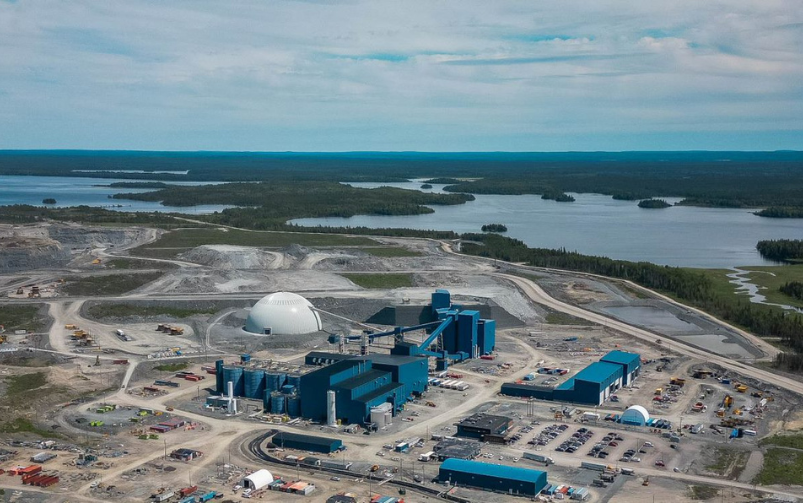New Gold’s wholly owned Rainy River mine in Ontario produced around 53,000 ounces of gold in the first quarter of this year and is on track for full underground production by 2027. Courtesy of New Gold.
Welcome back to your weekly mining news recap, where we catch you up on some of the news you may have missed. This week’s headlines include a settlement for the 2015 Mariana tailings dam collapse in Brazil, Agnico Eagle’s investment in Atex Resources and Electra Battery Materials securing more funding for its cobalt refinery project.
Canadian Copper has announced it will purchase the Caribou processing plant complex in New Brunswick. The $6.2 million deal, set to close on July 11, 2025, aims to accelerate production and derisking at the company’s nearby Murray Brook copper-zinc-lead-silver deposit. The company stated that integrating its Murray Brook deposit with the existing Caribou complex, last operated by Trevali Mining, will significantly cut costs and permitting time for producing copper, zinc and lead concentrate from the project.
Vale Base Metals has plans to construct a monument to pay tribute to its iconic Superstack in Sudbury, Ontario, which will be dismantled by 2029, as reported by Northern Ontario Business. The Superstack was decommissioned in 2020 as part of Vale’s efforts to reduce its sulfur dioxide emissions. Thousands of people voted in support of the monument in a poll on how to best commemorate the structure, which has been part of Sudbury’s horizon for several decades.
New Gold has announced the successful completion of key production milestones at its New Afton copper-gold mine in B.C. and its Rainy River gold mine in Ontario. At New Afton, the C-Zone, the mine’s fourth block cave, achieved commercial production early, thanks to a newly installed materials handling system for ore transportation. Meanwhile, at Rainy River, first underground ore was mined early, positioning the mine to start stoping in the first half of next year and also ramp up to the full underground production rate of 5,500 tonnes per day by 2027.
BHP, Vale and their joint venture Samarco have reached a nearly US$30 billion settlement with Brazil for reparations following the Mariana tailings dam collapse on Nov. 15, 2015, which resulted in 19 deaths. The agreement includes almost US$18 billion in payments over 20 years to public authorities, in addition to payments of almost US$17,000 per person for eligible fishermen and farmers in affected areas. BHP still faces a potential US$47 billion lawsuit in London, U.K.’s High Court for the disaster, while Vale is also being taken to court in The Netherlands.
Agnico Eagle Mines is investing $55 million into exploration company Atex Resources, which is headquartered in Toronto, in exchange for a 13 per cent stake in the company. The funds will be used to aid exploration at Atex’s Valeriano copper-gold project in Chile and allow the company to repay the remaining balance on its credit facility. The deal is expected to close this week.
Electra Battery Materials will receive US$5 million in financing from its existing lenders to initiate early works and winter preparations for its proposed cobalt sulfate refinery in Temiskaming Shores, Ontario, as reported by Mining.com. The refinery, which could be the first cobalt sulfate refinery in North America to produce battery-grade materials used in lithium-ion batteries, is expected to cost about US$250 million to build, and still requires US$60 million in funding. The project is projected to produce up to 6,500 tonnes of cobalt annually once it is fully commissioned.
Mali’s military junta has warned that it may revoke Barrick Gold Corp.’s Loulo gold mine concession when the current permit expires in February 2026, as reported by Bloomberg. The country’s Finance Minister Alousséni Sanou stated that Mali has the right to not renew Loulo’s operating permit and invited Barrick to discussions about the mine’s future. Tensions have escalated recently between Barrick and the junta, which included the brief detention of four of Barrick’s senior employees, as the government seeks more control over Mali’s mining sector.
A recent Wood Mackenzie report warned that the world is on track for 2.5 degrees Celsius to 3 degrees Celsius above pre-industrial level temperatures by this century’s end, necessitating a US$78 trillion investment by the mining and energy sectors to achieve net-zero emissions by 2050, as reported by Mining.com. The report highlights the need for investment in power supply and grid infrastructure, along with the critical minerals needed to support energy transition technologies. Additionally, it stated that emerging technologies like carbon capture and nuclear power will be vital for achieving cleaner energy.
The Diavik diamond mine, owned and operated by Rio Tinto in the Northwest Territories, is set to close in early 2026 after almost 25 years of operation, having so far produced over 144 million carats of diamonds, as reported by Ailbhe Goodbody for the September/October issue of CIM Magazine. Rio Tinto aims to leave a positive legacy in the region through a responsible closure plan that involves significant environmental reclamation efforts and the establishment of renewable energy infrastructure, such as its recently completed solar power plant.
Extreme weather events such as wildfires and flooding are becoming more frequent due to climate change, significantly impacting the mining industry, especially in Canada, which faced unprecedented wildfires during 2023, as reported by Trish Saywell for the September/October issue of CIM Magazine. Mining companies are being advised to integrate advanced weather forecasting technologies to mitigate these risks, as the financial costs of inaction can be substantial.
That’s all for this week. If you’ve got feedback, you can always reach us at editor@cim.org. If you’ve got something to add, why not join the conversation on our Facebook, Twitter, LinkedIn or Instagram pages?




